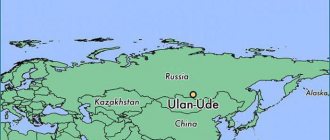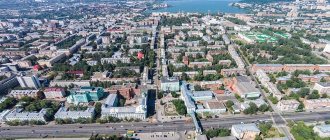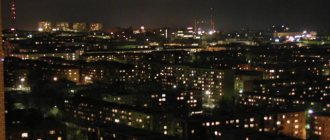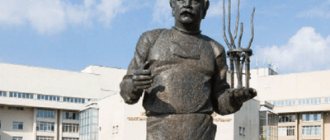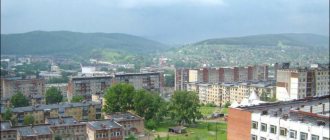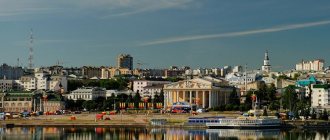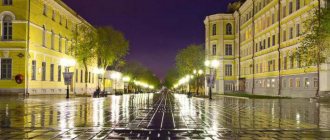The Republic of Mordovia
(m., e.
Mordovia Respublikas
),
Mordovia
(m., e.
Mordoviyas
),
RM
is a republic (state), an equal subject of the Russian Federation. The capital is Saransk (339.5 thousand people, as of January 1, 2002). The population of the Republic of Moldova is 910 thousand people. (as of January 1, 2002). The official languages are Russian and Mordovian languages (Moksha and Erzya).
The Republic of Mordovia is located in the central part of the East European (Russian) Plain, between the Oka and Sura rivers. The area of the Republic of Moldova is 26.1 thousand km². The length from west to east is about 280 km, from north to south – from 55 to 140 km (coordinates 53° 40′ and 55° 15′ N, 42° 12′ and 46° 43′ E) . It borders: in the west - with Ryazan, in the north - with Nizhny Novgorod, in the east - with Ulyanovsk, in the south - with Penza regions, in the northeast - with the Chuvash Republic. The distance from Moscow to Saransk is 642 km. Part of the Volga Federal District.
The Republic of Mordovia is part of a densely populated and well-developed zone of the Russian Federation. The most important railway, pipeline and highway routes pass through the territory of the republic, connecting the European part of Russia with the Urals, and the north with the Volga region. A developed national economic complex with diversified industry and agriculture has been created.
[edit] Government system
The Republic of Mordovia has on its territory all the fullness of state power, with the exception of powers assigned in accordance with the Constitution of Russia to the jurisdiction of the Russian Federation, as well as those that are the subject of joint jurisdiction of the Russian Federation and the Republic of Mordovia in accordance with the Constitution of Russia and the Constitution of the Republic of Mordovia (see Constitutional and legal status Republic of Mordovia).
State power in the Republic of Moldova is exercised on the basis of division into legislative, executive and judicial. The system of government bodies of the Republic of Moldova includes:
- The Head of the Republic of Mordovia is the highest official elected on the basis of universal, equal and direct suffrage by secret ballot for a period of 5 years. Heads the Government of the Republic of Moldova, in agreement with the State Assembly of the Republic of Moldova, appoints the Chairman of the Government, approves its structure;
- The State Assembly of the Republic of Moldova (unicameral) is the highest legislative (representative) body of state power of the Republic of Moldova, elected for 4 years. His jurisdiction includes introducing amendments to the Constitution of the Republic of Moldova, implementing legislative initiatives in the State Duma of the Federal Assembly of the Russian Federation, monitoring the implementation of the legislation of the Russian Federation and the Republic of Moldova, as well as the budget of the Republic of Moldova, exercising other powers assigned by the Constitution of the Republic of Moldova and the laws of the Republic of Moldova;
- The Government of the Republic of Mordovia is the permanent highest executive body of the Republic of Moldova, formed and headed by the Head of the Republic of Moldova, accountable to the State Assembly of the Republic of Moldova. Consists of the chairman, deputy chairman, ministers and other heads of executive bodies of state power of the Republic of Moldova. Develops the budget of the republic and ensures its execution; develops programs for the socio-economic development of the Republic of Moldova; carries out management of the property of the Republic of Moldova and other powers assigned to it by the Constitution of the Republic of Moldova, federal laws, laws of the Republic of Moldova and other regulatory legal acts of the Russian Federation;
- The judicial system of the Republic of Moldova is a link in the unified judicial system of the Russian Federation. Established by the Constitution of the Russian Federation, federal laws, the Constitution of the Republic of Moldova and the laws of the Republic of Moldova.
In cities, towns, rural settlements and other territories of the Republic of Moldova, management is carried out by local government bodies. Local self-government is implemented through various forms of expression of the will of the population (referendums, meetings, gatherings, etc.), elected and other self-government bodies; ensures that the population independently resolves issues of local importance and manages municipal property.
The Republic of Mordovia has its own state symbols: coat of arms, anthem and flag.
In accordance with the Constitution of the Russian Federation and federal laws, territorial structures of federal government bodies operate on the territory of the Republic of Moldova. Coordination of their activities to implement the policy of the President of the Russian Federation in the republic is ensured by the plenipotentiary representative of the President of the Russian Federation in the Volga Federal District and the Chief Federal Inspector for the Republic of Mordovia appointed by him.
[edit] Settlement and urbanization
Mordovian family.
Photo from the archive of M.E. Evseviev The settlement system in Mordovia was initially dispersed due to the landscape and historical features of the territory. This is due to the inclusion of Russians and Tatars in the traditional area of settlement of the Mordovians (Erzi and Moksha), as well as the active participation of the Mordovians in the economic development of the territory of Russia. The modern territory of the Republic of Moldova still retains the features of radial-ring settlement structures that were formed during the laying of abatis and the construction of fortified lines. If the 1st line Alatyr - Temnikov - Kadom - Shatsk (1556) is no longer connected with the system of modern communications, then Simbirskaya (1648-1654) is clearly visible in the supporting framework of the settlement of Mordovia. The Simbirsk fortified line began in Tambov and passed through a number of now small towns in the Tambov, Penza, Ulyanovsk regions and the Republic of Moldova. The radial-ring structures of cities closest to Mordovia on this line form Nizhny Lomov and Verkhny Lomov (center of the structure), Insar (loses its central status due to the lack of roads of various types), Ruzaevka (railway center), Saransk (administrative center). Then the line went to the southeast, to Inza (railway junction) and Simbirsk (Ulyanovsk). The construction of fortified cities (Krasnoslobodsk) and forts (Atemarsky, Troitsky, Shishkeevsky, Potizhsky) in the intervals of the main fortified lines and serif lines created a framework for rural settlements. According to the 1926 census, the entire population of Mordovia was concentrated in 2,135 settlements. After transformation into MAO, their number increased to 2,208, despite the decrease in population. In 1939, the number of settlements reached 2,542. The creation of new settlements through administrative means (MTS, timber industry enterprises, peat mining, railway sidings, etc.) and the urbanization of the territory led to a reduction in the number of settlements. The modern spatial framework of settlement is characterized by polarization. More than 45% of the population is concentrated in a 30-kilometer zone around the administrative capital of Mordovia - Saransk. The bulk of the urban population is concentrated along the railways from Pichkiryaev to the west to Ardatov to the east. The industrial potential of Mordovia is concentrated in the central and eastern parts.
The average number of inhabitants in the Mordovian villages of the Volga region has traditionally been higher than in Russian and Tatar ones. So, in the Penza province at the beginning of the 20th century. the average number of inhabitants in Mordovian villages was 680 people, Russians - 530, in Tatar villages - 510 people. Among the Mordvins there were almost no villages with less than 100 inhabitants, while among the Russians every tenth had such a population. The decline in population was accompanied by a reduction in the population of rural settlements and their number. The number of very large (1,000 - 3,000 people) and very small (up to 100 people), usually Russian settlements, decreased especially sharply. The exceptions are regional centers and railway stations. The average population of rural settlements in 1989 was 350 inhabitants. Since 1926 (601 people) it has decreased by almost half.
Active urbanization in Mordovia began in the post-war period. By 1959, the urban population had more than doubled, and over the next 10 years it doubled again. The number of workers' settlements during this time increased to 19. In 1989, more than 120 thousand people lived in them.
Saransk, the capital of the Republic of Moldova and the center of the agglomeration, as the center of Mordovian autonomy, was formed in a historically short period of time - 70 years. The permanent population of Saransk as of January 1, 2002 was 339.5 thousand people. with adjacent rural and urban settlements (without them - 310.8 thousand people). The urban population numbered 333.2 thousand people, the rural population - 6.3 thousand people.
[edit] History
On July 16, 1928, the Mordovian Okrug was created as part of the Middle Volga region; on January 10, 1930, it was transformed into the Mordovian Autonomous Region. From December 20, 1934 - Mordovian Autonomous Soviet Socialist Republic, from December 7, 1990 - Mordovian Soviet Socialist Republic, from January 25, 1994 - Republic of Mordovia. The current Constitution of Mordovia was adopted by the Constitutional Assembly of the Republic of Moldova on September 21, 1995. For success in the development of the national economy, science and culture, the Republic of Moldova was awarded 2 Orders of Lenin (1965, 1985), the Order of Friendship of Peoples (1972), and the Order of the October Revolution (1980).
[edit] Migration
Children in national clothes Since the 1930s. Mordovia mainly lost its population due to migration, especially in rural areas. Every year, 2-3 thousand people left the villages. more than arrived in the cities of Mordovia, i.e. the population traveled outside the republic. In 1960, the migration outflow was maximum - 11,276 people. In 1986-1996. there was a positive balance of migration (2-3 thousand people per year, primarily Russians and Mordovians from the republics of the former Soviet Union). Since 1997, migration in the republic has been characterized by an outflow of population. There is a noticeable decrease in migration influx:
- In 1992, the number of births was 10,215 people. (per 1000 people - 10.6), deaths - 11,574 (per 1000 people - 12), natural decline - -1,359 (per 1,000 people - -1.4), number of marriages - 7,235 (per 1,000 people - 7.5), the number of divorces - 2,742 (per 1,000 people - 2.8).
- In 1993, the number of births was 9,276 people. (per 1,000 people - 9.6), deaths - 13,217 (per 1,000 people - 13.7), natural decline - -3,941 (per 1,000 people - -4.1), number of marriages - 7,412 ( per 1000 people - 7.7), the number of divorces - 2,969 (per 1000 people - 3.1).
- In 1994, the number of births was 8,916 people. (per 1000 people - 9.3), deaths - 14,748 (per 1000 people - 15.3), natural decline - -5,832 (per 1,000 people - -6), number of marriages - 6,865 (per 1,000 people - 7.1), the number of divorces - 3,223 (per 1000 people - 3.4).
- In 1995, the number of births was 8,589 people. (per 1,000 people - 9), deaths - 13,460 (per 1,000 people - 14.1), natural decline - -4,871 (per 1,000 people - -5.1), number of marriages - 6,670 (per 1,000 people - 7), the number of divorces - 3,131 (per 1000 people - 3.3).
- In 1996, the number of births was 7,883 people. (per 1000 people - 8.3), deaths - 13,579 (per 1000 people - 14.2), natural decline - -5,696 (per 1000 people - -5.9), number of marriages - 5,542 ( per 1000 people - 5.8), the number of divorces - 2,710 (per 1000 people - 2.8).
- In 1997, the number of births was 7,493 people. (per 1000 people - 7.9), deaths - 13,631 (per 1000 people - 14.4), natural decline - -6,138 (per 1000 people - -6.5), number of marriages - 5,875 ( per 1000 people - 6.2), the number of divorces - 2,784 (per 1000 people - 2.9).
- In 1998, the number of births was 7,469 people. (per 1,000 people - 7.9), deaths - 13,116 (per 1,000 people - 13.9), natural decline - -5,647 (per 1,000 people - -6), number of marriages - 5,324 (per 1,000 people - 5.7), the number of divorces - 2,123 (per 1000 people - 2.3).
- In 1999, the number of births was 6,994 people. (per 1000 people - 7.5), deaths - 14,200 (per 1000 people - 15.2), natural decline - -7,206 (per 1000 people - -7.7), number of marriages - 5,610 ( per 1000 people - 6), the number of divorces - 2,354 (per 1000 people - 2.5).
- In 2000, the number of births was 7,148 people. (per 1,000 people - 7.7), deaths - 14,838 (per 1,000 people - 16), natural decline - -7,690 (per 1,000 people - -8.3), number of marriages - 5,703 (per 1,000 people - 5.8), the number of divorces - 3,947 (per 1,000 people - 3.4).
- In 2001, the number of births was 7,049 people. (per 1000 people - 7.7), deaths - 14,200 (per 1000 people - 15.5), natural decline - -7,151 (per 1000 people - -7.8), number of marriages - 5,703 ( per 1000 people - 6.2), the number of divorces - 3,947 (per 1000 people - 4.3).
- In 1991, 28,121 people arrived in the Republic of Moldova, 25,893 left, migration increase (decrease) was 2,228.
- In 1992, 21,748 people arrived in the Republic of Moldova, 18,660 left, migration increase (decrease) was 3,088.
- In 1993, 18,764 people arrived in the Republic of Moldova, 16,578 left, migration increase (decrease) was 2,186.
- In 1994, 18,772 people arrived in the Republic of Moldova, 16,368 left, migration increase (decrease) was 2,404.
- In 1995, 18,845 people arrived in the Republic of Moldova, 17,934 left, migration increase (decrease) was 911.
- In 1996, 16,671 people arrived in the Republic of Moldova, 16,277 left, migration increase (decrease) was 394.
- In 1997, 14,039 people arrived in the Republic of Moldova, 14,334 left, migration increase (decrease) was -295.
- In 1998, 13,129 people arrived in the Republic of Moldova, 13,894 left, migration increase (loss) -765.
- In 1999, 11,246 people arrived in the Republic of Moldova, 12,126 left, migration increase (loss) -880.
- In 2000, 11,350 people arrived in the Republic of Moldova, 12,989 left, migration increase (decrease) - -1,639.
- In 2001, 9,861 people arrived in the Republic of Moldova, 12,438 left, migration increase (decrease) - -2,577.
In interregional exchange, the number of those leaving Mordovia exceeds the number of arrivals from other regions of Russia. The greatest outflow occurs to the city of Moscow, to the Nizhny Novgorod, Moscow and Samara regions. More than half of the population movements in the volume of migration are associated with the intra-republican flow, which is characterized by further migration of the population from rural to urban areas. The excess of the number of arrivals in Mordovia (more than 4 times) over the number of those leaving its territory occurred only in the exchange of population with neighboring countries. Moreover, more than half of the migration growth accounted for Kazakhstan (25.3%) and Uzbekistan (30.6%). Among those arriving from the CIS and Baltic countries, 55% (225 people) are recognized as internally displaced persons. More than 80% of forced migrants are former residents of Kazakhstan and Uzbekistan.
[edit] Population migration by streams
In 1999, a total of 11,246 people arrived, 12,126 left, and the migration loss was -880 people. Migration within Russia was: arrivals 10,206 people, departures - 11,821, migration loss - 1,615 people. (including intraregional: profits - 6,411, losses - 6,411, migration gain (loss) - 0; interregional: profits - 3,795, losses - 5,410, migration gain (loss) - -1,615). International migration: arrivals 1,040 people, losses - 305, migration increase - 735 people. (including with the CIS countries: profit - 0, loss - 0, migration gain (loss) - 0; Baltic countries: profit - 1,040, loss - 305, migration gain (loss) - 779; with other foreign countries: profit - 0, loss - 0, migration increase (decrease) - -44).
In 2001, a total of 9,861 people arrived, 12,438 left, and the migration loss was -2,577 people. Migration within Russia amounted to: arrivals - 9,450 people, losses - 12,304, migration loss - -2,854 people (including intraregional: arrivals - 6,629, losses - 6,629, migration increase (loss) - 0; interregional: profits - 2,821, losses - 5,675, migration increase (decrease) - -2,854). International migration: arrivals 411 people, departures - 134, migration increase - 277 people. (including with the CIS countries: profits - 0, losses - 0, migration growth (loss) - 0; Baltic countries: profits - 409, losses - 112, migration growth (loss) - 297; with other foreign countries: profits - 2 , loss - 22, migration increase (decrease) - -20).
The population of working age has the highest migration mobility. Its share in the total volume of migration is about 73%, including half of young people aged 16-29 years. The number of people of working age who left the republic is greater than those who arrived. Due to the change of work, 1.5 times more people left Mordovia than arrived on its territory.
[edit] Administrative-territorial division
The Republic of Mordovia includes one city of republican subordination (Saransk and 22 municipal districts:
- Ardatovsky municipal district, district center - Ardatov;
- Atyuryevsky municipal district, district center - village. Atyurevo;
- Atyashevsky municipal district, district center - village. Atyashevo;
- Bolshebereznikovsky municipal district, district center - village. Bolshie Berezniki;
- Bolsheignatovsky municipal district, district center - village. Bolshoye Ignatovo;
- Dubyonsky municipal district, district center - village. Dubyonki;
- Elnikovsky municipal district, district center - village. Elniki;
- Zubovo-Polyansky municipal district, district center - village. Zubova Polyana;
- Insar municipal district, district center - the city of Insar;
- Ichalkovsky municipal district, district center - village. Kemlya;
- Kadoshkinsky municipal district, district center - village. Kadoshkino;
- Kovylkino municipal district, district center - Kovylkino;
- Kochkurovsky municipal district, district center - village. Kochkurovo;
- Krasnoslobodsky municipal district, district center - Krasnoslobodsk;
- Lyambirsky municipal district, district center - village. Lambir;
- Romodanovsky municipal district, district center - village. Romodanovo;
- Ruzaevsky municipal district, district center - Ruzaevka;
- Staroshaigovsky municipal district, district center - village. Old Shaigovo;
- Temnikovsky municipal district, district center - Temnikov;
- Tengushevsky municipal district, district center - village. Tengushevo;
- Torbeevsky municipal district, district center - village. Torbeevo;
- Chamzinsky municipal district, district center - village. Chamzinka.
[edit] Population
Main article
:
Population of the Republic of Mordovia
Mordovians (Moksha, Erzya), Russians, Tatars, Ukrainians, Belarusians and representatives of other nationalities live on the territory of Mordovia.
In the 20th century The Republic of Mordovia, like Russia as a whole, is characterized by wave-like dynamics of the total population size and density. The maximum population was recorded in 1929 - 1,369.9 thousand people. Reduction of the network of rural settlements in the 1950-1980s. served as a catalyst for depopulation. A slight increase in its numbers was noted in the post-war period. In 1969 it amounted to 1,040 thousand people. Since 1970, the population of the republic has been constantly declining. This is due to significant natural decline and negative balance of population migration.
Economic status of Mordovia
Mordovia plays a significant role in the economic situation of our large country. The main directions of the economy of this republic are manufacturing and agriculture. Particularly well developed are such industries as metalworking, mechanical engineering, woodworking, chemical and electrical engineering.
The republic has excellent potential for the development of scientific activity, which completely compensates for the lack of deposits of any minerals. The only thing that makes the subsoil of Mordovia valuable is the variety of ceramic clay and the presence of mineral waters. With the help of state support, scientific centers have been created and built in the republic, where the most innovative and modern technologies are being developed. Mordovia is distinguished by its fertile lands, which are excellent conditions for the development of the agricultural sector. Therefore, both crop production and livestock farming are actively developing in the republic. Since the region is constantly developing and shows positive dynamics, the standard of living in Mordovia is gradually increasing. There is a positive trend in average life expectancy in the republic.
[edit] Nature
Main article
:
Nature of the Republic of Mordovia
Coniferous-deciduous and broad-leaved forests, shrub and meadow steppes are widespread on the territory of Mordovia. The flora includes more than 1,230 species of vascular plants from 495 genera and 109 families. Of these, 4 are species of clubmosses, 8 are horsetails, 18 are ferns, 3 are gymnosperms, and the rest are flowering plants. Herbaceous plants predominate; the number of tree and shrub species is small. The main forest-forming species: pine, spruce, larch, English oak, ash, sycamore maple, elm, warty and downy birch, alder, small-leaved linden, black poplar.
In Mordovia, 63 species of mammals (of which 35 are rare), 267 species of birds (70 rare), and 44 species of fish live in the reservoirs of the republic. The world of insects is rich (more than 1,000 species), but the diversity of reptiles and amphibians is small. The fauna consists of representatives of the forest fauna (elk, wild boar, lynx, marten, white hare, wood grouse, hazel grouse, woodpeckers, blackbirds, tits) and, to a lesser extent, steppe fauna (speckled gopher, steppe mole rat, common mole rat, great jerboa).



